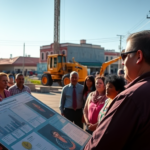Heart of the Valley: STHS Aims to Reduce Diabetes-Related Amputations Through New Center
A promising initiative is underway in the Rio Grande Valley as South Texas Health System (STHS) launches a dedicated Amputation Prevention Center. The center is designed to address the alarming rates of diabetes-related amputations in the region, offering advanced procedures aimed at improving blood circulation to prevent severe complications.
A Groundbreaking Approach to Amputation Prevention
In the Rio Grande Valley, diabetes poses a significant health challenge, with a notably high prevalence rate compared to other parts of the United States. With this concern in focus, the STHS’s new Amputation Prevention Center introduces innovative procedures that help mitigate risks associated with poor blood flow in diabetic patients. These include techniques to destroy plaque buildup in the arteries, thereby restoring blood flow and aiding in the healing of wounds.
Dr. Ofsman Quintana, an Interventional Cardiologist at STHS Edinburg, explained, “This is not a cure for diabetes or atherosclerosis, but it does provide blood flow necessary to heal wounds and prevent amputations. Patients are able to have the procedures done without general anesthesia and often return home the next day.”
The Local Impact: A Needed Resource for the Valley
The launch of the Amputation Prevention Center holds particular significance for the Rio Grande Valley, where health services often struggle to keep pace with the demands placed by chronic conditions such as diabetes. The initiative promises improved health outcomes for Valley residents, reducing the incidence of life-altering amputations and fostering better quality of life.
Dr. Quintana emphasized the broader implications, stating, “By reducing the number of amputations, we are not only improving individual lives but also alleviating economic burdens on families and healthcare systems. Prevention is key in managing diabetes effectively.”
Path to Prevention: Building on Past Efforts
The establishment of this center builds upon previous regional efforts to combat diabetes and its complications. With educational campaigns and improved access to healthcare, the Valley has made strides, yet the rate of diabetes diagnoses remains high, necessitating continued focus and innovative solutions.
Healthcare advocate and local community leader Ana Gutierrez highlighted the importance of continuity in these efforts. “The success of the Amputation Prevention Center can set a standard for similar interventions in other parts of South Texas. It illustrates that investing in health infrastructure can yield substantial dividends in public health,” she noted.
Future Prospects and Community Engagement
As this initiative marks a new chapter in regional healthcare development, it also reflects a proactive shift toward addressing systemic health issues with targeted interventions. With ongoing success, similar centers could be deployed throughout South Texas, further expanding access to necessary medical care in underserved areas.
However, the center’s operations must be complemented by comprehensive lifestyle management for affected individuals. Preventative health education, dietician support, and community fitness programs can augment the center’s impact, providing holistic approaches to dealing with diabetes.
“h2>Engaging with the Community
For local residents seeking more information about the services offered by the Amputation Prevention Center, STHS is scheduled to host informational sessions and community outreach programs throughout the Valley. These initiatives aim to raise awareness about prevention strategies and encourage early diagnosis and treatment.
The efforts extend beyond medical intervention, focusing on building strong community ties and addressing social determinants of health. Collaborative endeavors among healthcare providers, local organizations, and patient groups are essential for reducing the disease’s impact economically and socially.
Sharing Perspectives
While the center’s establishment is a commendable advancement, it’s imperative to balance expectations with pragmatic planning. Ensuring that resources for ongoing education and lifestyle changes are available to the Valley’s diverse populations will be essential for long-term success.
Health policy expert Dr. Ricardo Mendoza underscores the significance of a multifaceted approach, “Community engagement is vital. By integrating medical expertise with cultural understanding, we can tailor interventions that resonate well with the community, yielding better health outcomes.”
Resources for Residents
Residents can reach out to the STHS Amputation Prevention Center at (956) 388-6000 for more information or to schedule consultations. Additionally, detailed program information will be available on their website, ensuring that Valley residents are well-informed and adequately supported.
Overall, the launch of the Amputation Prevention Center signals a beacon of hope for the Rio Grande Valley, setting the stage for improved preventive healthcare measures that can transform lives and communities in South Texas.







